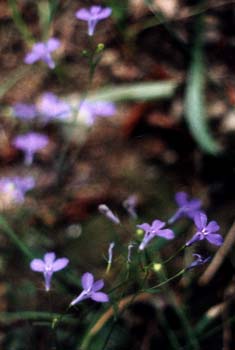
"Volunteers,"
those unexpected garden arrivals
Most gardeners now & then discover flowers in their yard they never planted. Sometimes these are native weeds or wildflowers that are simply too pleasant to remove, or they are naturalized invasives that have become defacto native wildflowers, or they are gardened varieties that escaped from other people's gardens.
In the context of volunteers, I have made very little effort to discourage Dove's-foot Crane's-bill, but I do always remove Sweet Peas when they spring up. When a creeping potatoe vine appeared at the edge of a path, I wasn't sure what it was at first, but I let it creep around prettily as it pleased, then it burst forth with bright blue yellow-hearted blossoms that allayed any doubt it was potatoe vine.
The coolest volunteer in our garden is today an enormous shrub or small tree, our native Pacific Red Elderberry which appeared in the garden, was cared for, & today dominates a shade corridor.
Another common volunteer is native maple. The most common one to erupt about the gardens seems to be Acer macrophyllum. A couple of years before we bought this house, the street was shaded by these maples, but alas they developed rotted centers with old age & for safety sake were removed. But some of those lost trees' offspring are in a woodland patch half a block away, & the whirly-seeds are able to cover that much distance. The seedlings are very pleasant but of course they would in time become enormous trees, so I usually pull them, but sometimes I leave certain ones until they're pleasantly bushy.
Sometimes I save some unexpected plant because I don't know what it is. I took care of quite a lovely weed for a while until I discovered it was potentially harmful knapweed, then I got rid of it. On the other hand, when a vine I never planted turned out to be deadly nightshade, I was no less delighted by it, & it has over time become a very pleasing permanent resident of the back yard.
The picture at the top of the page taken in August is one of our volunteers. It is almost certainly Lobelia erinus the Edging Lobelia or Trailing Lobelia, though I'm not entirely certain I could tell it apart from L. richardii if it were that instead. It springs up all about the shade garden under the choke cherry, under the rohani beach, under the evergreen huckleberry. It obviously likes shady places. I'm afraid much of it gets pulled up accidentally when not in bloom, but whenever I realize what it is I leave it. It's only about two or three inches tall, a creeper that spreads about six inches, so is easily overwhelmed by other plants.
Native of the Cape of Good Hope, it has been in English & American gardens for two hundred years. Commonly grown in mixed hanging baskets, we never planted this anywhere nor ever had it in a container, but it thoroughly naturalizes in damp cool shady places, doubtless just from seeds that arrived on the wind. It blooms all summer & into well into autumn; it's still providing sparkly blue spots of color in November.
It is usually an extremely tender perennial, usually categorized as an annual. It comes in many colors. The blue, & our purple-blue, are commonest.
 A much more typical local volunteer is Forget-Me-Nots (Myosotis sp.) Just about everyone who gardens in the Northwest has Forget-Me-Nots without ever needing to plant any. It is a teency tiny plant with itty bitty flowers, but of such a brilliant pure blue they are stand-outs.
A much more typical local volunteer is Forget-Me-Nots (Myosotis sp.) Just about everyone who gardens in the Northwest has Forget-Me-Nots without ever needing to plant any. It is a teency tiny plant with itty bitty flowers, but of such a brilliant pure blue they are stand-outs. The Forget-me-Nots spring up in both sunny & shady areas all summer, a hardy self-seeding annual that naturalizes with abandon. I occasionally spot it blooming even in thick grass. If they weren't so awfully small they'd be regarded as invasive pests, but for an unexpected spot of blue here & there, they are perfectly welcome. When planted intentionally they can form a nice little groundcover of leaves & flowers, but the volunteers we've had have rarely covered an area larger than a silver dollar. They show themselves April through September.